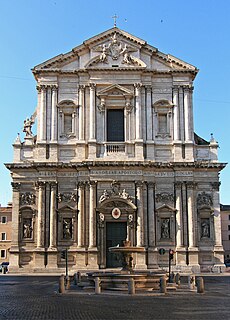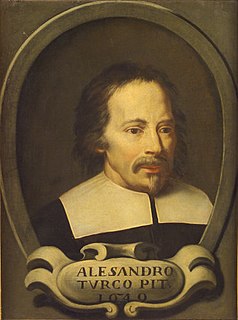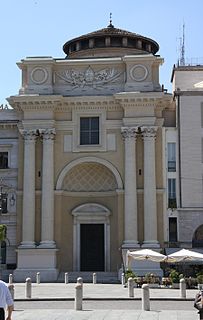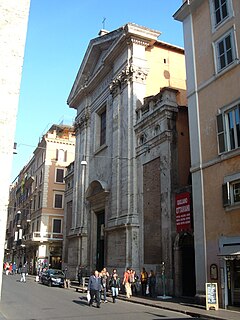
San Vitale is a Baroque style, Roman Catholic church located in central Parma, region of Emilia Romagna, Italy.

San Vitale is a Baroque style, Roman Catholic church located in central Parma, region of Emilia Romagna, Italy.
A religious building at the site existed in the 9th century, dedicated to San Vitale, tradition holds it was founded by King Pepin of Italy. The present layout dates to a reconstruction that took place from 1651 to 1658 by the architect Cristoforo Rangoni, also called Ficarelli. Domenico Valmagini reinforced the dome in 1676. In 1913, the property was appropriated by the town.
The façade was decorated by the sculptor Felice Pascetti and has six statues attributed to Pietro Sbravati depicting Saints Vitalis and Valeria above, with Valeria's bride and children under the external sides, as well as Saints Gervasius and Protasius, and in the niches Saints Gregory Magnus and Ambrose.

The first chapel on the right has a painting of the Charity of San Carlo Borromeo by Mauro Oddi.
The second chapel on the right has a Madonna di Caravaggio by Carlo Francesco Nuvolone.
The 3rd chapel on the right has a Saints Anthony, Francis Xavier, and Virgin with Child. Over a door is a large canvas depicting St Gregory praying for Souls in Purgatory by Giovanni Tebaldi.
In the 1st chapel on the left is a St Tiburzio Martyr forced to burn before an idol by Clemente Ruta and a marble Ecce Homo by Giocondo Viglioli.
In the 3rd chapel on the left is a Meeting of St Francis of Paola with King Louis XI of France at Ambois by Gaetano Callani.
The altar in polychrome marble was designed by Pietro Righini, with statuary sculpted by Moggiani. The main altarpiece in the church now was painted Michele Plancher. Originally, the church had a large work by Sebastiano Ricci, but this was looted by Napoleon's armies.
The frescoes in the Sanctuary and the ceiling (1763) were painted by the Abbot Giuseppe Peroni; the quadratura ornamentation (1760) was completed by Gaspare Bazzani and Antonio Betti.
The first chapel on the right is dedicated to the Holy Virgin of Constantinople or the Virgin of Deliverance (Madonna del Riscatto); the stucco decoration was completed in 1669 by Luca and Domenico Reti (or Reddi).
The second chapel has a 17th-century altarpiece depicting Phillip Neri meets St Felice Cappuccino at Montecavallo by Giovanni Battista Caccioli.
The fourth chapel has an altarpiece depicting the Charity of San Carlo Borromeo by Mauro Oddi. [1]
The church had a copy, painted by Rondani, made of its former masterpiece, Adoration of the Child by Correggio. There was also a Santa Cecilia attributed to Girolamo Mazzola.
The Assumption of the Virgin over the entrance was completed by Giovanni Gaibazzi, and donated to the church by Archduke Leopold of Austria.
An urn under the main altar putatively holds the relics of St Vital's body, brought in 1648 from Rome by Gherardo III of Sissa.
There is a Martyrdom of St John Nepomunk by Pietro Rubini and a Sacrifice of Isaac by a follower of Lionello Spada. Moreover, the church houses canvases by Matteo Rusca, Latino Barilli and Donnino Pozzi. [2] [3]

Sant'Andrea della Valle is a minor basilica in the rione of Sant'Eustachio of the city of Rome, Italy. The basilica is the general seat for the religious order of the Theatines. It is located at Piazza Vidoni, 6 at the intersection of Corso Vittorio Emanuele and Corso Rinascimento.

Carlo Maratta or Maratti was an Italian painter, active mostly in Rome, and known principally for his classicizing paintings executed in a Late Baroque Classical manner. Although he is part of the classical tradition stemming from Raphael, he was not exempt from the influence of Baroque painting and particularly in his use of colour. His contemporary and friend, Giovanni Bellori, wrote an early biography on Maratta.

The basilica diSan Pietro is a catholic basilica and abbey in the Italian city of Perugia.

Santa Maria in Vallicella, also called Chiesa Nuova, is a church in Rome, Italy, which today faces onto the main thoroughfare of the Corso Vittorio Emanuele and the corner of Via della Chiesa Nuova. It is the principal church of the Oratorians, a religious congregation of secular priests, founded by St Philip Neri in 1561 at a time in the 16th century when the Counter Reformation saw the emergence of a number of new religious organisations such as the Society of Jesus (Jesuits), the Theatines and the Barnabites.

Sant'Anna dei Lombardi,, and also known as Santa Maria di Monte Oliveto, is an ancient church and convent located in piazza Monteoliveto in central Naples, Italy. Across Monteoliveto street from the Fountain in the square is the Renaissance palace of Orsini di Gravina.

The Tempio della Beata Vergine della Ghiara, also known as Basilica della Madonna della Ghiara, is a church in Reggio Emilia, northern Italy. The building is the property of the comune (municipality) of the city.

San Nicola da Tolentino agli Orti Sallustiani is a church in Rome. It is referred to in both Melchiori's and Venuti's guides as San Niccolò di Tolentino, and in the latter it adds the suffix a Capo le Case. It is one of the two Roman national churches of Armenia. The church was built for the Discalced Augustinians in 1599, and originally dedicated to the 13th century Augustinian monk, St. Nicholas of Tolentino.

Alessandro Turchi was an Italian painter of the early Baroque, born and active mainly in Verona, and moving late in life to Rome. He also went by the name Alessandro Veronese or the nickname L'Orbetto. His style has been described as soft and Caravaggesque at the same time.

Pompeo Ghitti was an Italian painter of the Baroque period, active mainly in and in towns surrounding Brescia.

The Shrine of Santa Maria della Steccata is a Greek-cross design Renaissance church in central Parma, Italy. The name derives from the fence or steccato used to corral the numerous devotees who visited a venerated image of the Madonna. A Nursing Madonna is enshrined within, crowned on 27 May 1601 by a Marian devotee, Fray Giacomo di Forli of the Capuchin order.

The Madonna dell'Orto is a church in Venice, Italy, in the sestiere of Cannaregio.

The Chiesa della Santissima Trinità dei Pellegrini is a Roman Catholic church located on Via dei Pettinari #36 In the rione of Regola of central Rome, Italy. It stands a block away from the Palazzo Spada on Via Capo di Ferro, while a few blocks away on the Via dei Pettinari stands the Ponte Sisto.

San Pietro or San Pietro Apostolo is a Neoclassic-style, Roman Catholic church located on Piazza Garibaldi in Parma.

Gesù e Maria is a Baroque church located on Via del Corso in the Rione Campo Marzio of central Rome, Italy. It faces across the street the similarly Baroque facade of San Giacomo in Augusta.
The Sanctuary of Santa Maria di Galloro is a church located on the via Appia Nuova, near Ariccia on the road to Genzano di Roma, in the region of Lazio, in Italy.

The Church of Saint Roch is a late-Baroque style, Roman Catholic church dedicated to Saint Roch located in Parma, Italy.

The Church of Santa Sofia is a Roman Catholic church in the city of Lendinara, in the Province of Rovigo, region of Veneto, Italy.
The Collegiate Church of Santa Maria Assunta is a Gothic church located in Sermoneta, southern Lazio, Italy. The church is often referred to as a cathedral ("cattedrale") but has never been the seat of a bishop. It is dedicated to the Assumption of the Virgin Mary.
San Pietro in Valle is a baroque-style church located on Via Nolfi/Via San Francesco in the town of Fano, province of Pesaro and Urbino in the Marche region of Italy.

Andrea Carrera or Carreca was an Italian Baroque painter mainly active in Sicily. He was born in Trapani and died in Palermo.
Coordinates: 44°48′4.01″N10°19′44.78″E / 44.8011139°N 10.3291056°E